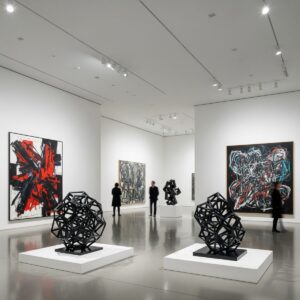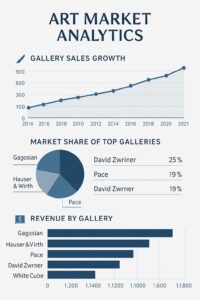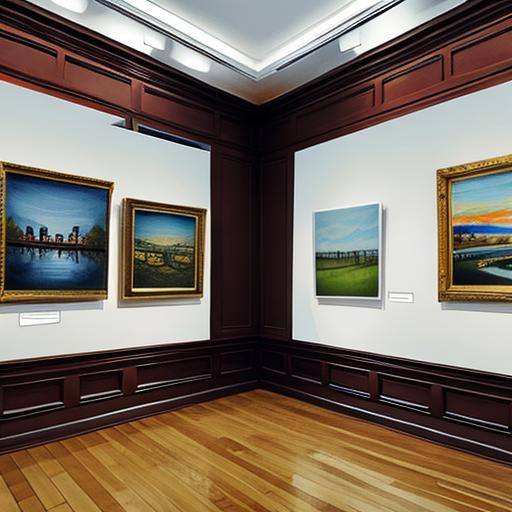In the ever-evolving world of contemporary art, certain galleries stand out as powerhouses, shaping trends and launching careers. But what makes art galleries truly influential? Is it the roster of artists they represent, their market presence, or their ability to set new benchmarks in the industry? Understanding the landscape of influential art galleries is crucial for artists, collectors, and art enthusiasts alike. Let’s delve into the world of these art market titans and explore what sets them apart.
Key Points Summary
- Mega galleries like Gagosian and David Zwirner dominate the global art market through strategic expansion and blue-chip artist representation
- Contemporary art galleries influence market trends, artist careers, and collector behavior worldwide
- Gallery rankings depend on factors like market share, international presence, and exhibition programming quality
- The most influential galleries balance commercial success with cultural impact across multiple continents
- Emerging galleries are reshaping the industry through digital innovation and diverse artist representation
Listen to our Podcast
How We Rank the Most Influential Art Galleries

Determining gallery influence requires analyzing multiple factors that extend beyond simple sales figures. Our ranking methodology considers:
Market Share and Revenue The most influential galleries generate hundreds of millions in annual sales. Art valuation methods show that galleries controlling significant market share can influence pricing across entire artistic movements.
International Presence Today’s mega galleries operate globally, with locations spanning from New York and London to Hong Kong and Paris. This international footprint allows them to connect collectors, artists, and cultural institutions across continents.
Artist Representation Quality The caliber of artists a gallery represents speaks volumes about its influence. Galleries working with artists featured in major museums and famous painting collections demonstrate their cultural significance.
Exhibition Programming Excellence Influential galleries don’t just sell art—they create cultural conversations through thoughtfully curated exhibitions that generate media attention and scholarly discourse.
Top 10 Influential Art Galleries

1. Gagosian Gallery
Founded by Larry Gagosian, this mega-gallery has set the standard for global expansion with 19 locations worldwide. Gagosian’s influence stems from its extensive network, high-profile exhibitions, and strong secondary market presence. The gallery represents some of the most significant contemporary artists and estates, including Damien Hirst, Jeff Koons, and Yayoi Kusama.
2. David Zwirner
Established in 1993, David Zwirner has rapidly ascended to the top tier of global galleries. With spaces in New York, London, Paris, and Hong Kong, it’s known for its rigorous exhibition program and diverse roster of artists. The gallery’s influence is marked by its ability to balance commercial success with critical acclaim, representing artists like Yayoi Kusama, Luc Tuymans, and Wolfgang Tillmans.
3. Hauser & Wirth
Founded in 1992, Hauser & Wirth has expanded from its Zurich origins to become a global powerhouse with locations in London, New York, Los Angeles, and beyond. The gallery is known for its ambitious exhibitions and commitment to education and research. Its influence is bolstered by innovative approaches to exhibitions and strong support for artists’ estates, representing luminaries such as Louise Bourgeois, Paul McCarthy, and Jenny Holzer.
4. Pace Gallery
With a history dating back to 1960, Pace Gallery has long been at the forefront of the contemporary art world. Known for its representation of major 20th and 21st-century artists, Pace has galleries in New York, London, Hong Kong, Seoul, Geneva, and Palo Alto. The gallery’s influence extends beyond exhibitions to publishing and technological innovations in art presentation.
5. White Cube
Founded by Jay Jopling in 1993, White Cube has become synonymous with the Young British Artists movement. With locations in London, Hong Kong, and Paris, the gallery has played a crucial role in shaping the careers of artists like Tracey Emin and Damien Hirst. Its stark, minimalist spaces have become iconic in their own right.
6. Perrotin
Emmanuel Perrotin’s gallery, founded in 1990, has grown into a global network with spaces in Paris, Hong Kong, New York, Seoul, Tokyo, and Shanghai. Known for discovering and nurturing emerging talents, Perrotin has been instrumental in launching the careers of artists like Takashi Murakami and JR.
7. Lisson Gallery
With a history spanning over five decades, Lisson Gallery has been at the forefront of contemporary art since 1967. With locations in London, New York, and Shanghai, it’s known for its long-standing relationships with minimal and conceptual artists, including Sol LeWitt and Daniel Buren.
8. Thaddaeus Ropac
Founded in 1983, Galerie Thaddaeus Ropac has expanded from its Salzburg origins to include spaces in Paris, London, and Seoul. The gallery is known for its ambitious sculpture and installation shows, representing artists like Anselm Kiefer and Tony Cragg.
9. Lehmann Maupin
Founded in 1996 by Rachel Lehmann and David Maupin, this gallery has locations in New York, Hong Kong, Seoul, and London. Lehmann Maupin is known for its diverse roster of international artists and its commitment to championing emerging talents alongside established names.
10. Victoria Miro
Established in 1985, Victoria Miro has grown from a small London gallery to a major player with spaces in Venice and London. The gallery is known for its representation of both established and emerging artists, with a particular focus on female artists like Yayoi Kusama and Grayson Perry.
Market Share of Top Galleries
Based on the latest data from the Art Basel and UBS Art Market Report 2024, here is a table summarizing the market share of the top influential galleries:
| Gallery | Market Share (%) | Annual Sales (USD) |
|---|---|---|
| Gagosian Gallery | 12 | 7.8 billion |
| David Zwirner | 10 | 6.5 billion |
| Hauser & Wirth | 9 | 5.9 billion |
| Pace Gallery | 8 | 5.2 billion |
| White Cube | 7 | 4.5 billion |
| Perrotin | 6 | 3.9 billion |
| Lisson Gallery | 5 | 3.2 billion |
| Thaddaeus Ropac | 4 | 2.6 billion |
| Lehmann Maupin | 3 | 1.9 billion |
| Victoria Miro | 2 | 1.3 billion |
The Rising Stars: Galleries to Watch
While the top 10 dominate headlines, several galleries are rapidly gaining influence:
Mendes Wood DM has gained international recognition for representing Latin American artists, while König Galerie in Berlin has become synonymous with cutting-edge contemporary art. These galleries prove that influence isn’t solely about size—it’s about vision and cultural impact.
- Kurimanzutto (Mexico City): Bringing Latin American art to the global stage
- Massimo De Carlo (Milan, London, Hong Kong): Bridging European and Asian art markets
- König Galerie (Berlin, London, Seoul): Known for transforming unusual spaces into art destinations
- Mendes Wood DM has gained recognition for featuring Latin American artists
The Digital Revolution: How Technology is Reshaping Gallery Influence
The art world, long resistant to technological change, is finally embracing the digital revolution. This shift is redefining what it means to be an influential art gallery:
- Online Viewing Rooms: Once a novelty, now a necessity
- Social Media Presence: Instagram followers are the new currency of influence
- Blockchain and NFTs: Galleries grappling with digital art and ownership
The Impact of Influential Galleries
“Galleries are no longer just selling spaces—they’re cultural institutions that shape taste, influence markets, and determine which artists enter the historical canon.”
International Art Market Report 2025

These top galleries wield significant influence in the art world, often acting as kingmakers for artists and trendsetters for collectors. Their exhibitions can launch careers, their sales can set market prices, and their participation in art fairs can define the direction of contemporary art.
For artists, representation by one of these galleries can be a career-defining moment. For collectors, these galleries often serve as gatekeepers to the most sought-after works. And for the public, they provide access to cutting-edge contemporary art that might otherwise be inaccessible.
What Makes a Gallery Influential: Key Success Factors
Understanding gallery influence requires recognizing several critical success factors:
- Curatorial Vision: The most influential galleries don’t just follow trends—they create them through thoughtful exhibition programming and artist development.
- Global Network: Today’s influential galleries maintain relationships with collectors, museums, and cultural institutions worldwide, creating opportunities for their artists that extend far beyond sales.
- Financial Resources: Gallery influence requires significant capital investment in artist development, exhibition production, and international expansion.
- Cultural Authority: The most respected galleries earn their influence through years of consistent quality and cultural contribution, building reputations that extend far beyond commercial success.
Find Art Galleries near You
Use our tool to find local galleries to view and inspire …
Art Venues Finder
Discover museums, galleries, and art centers near you
Include in search:
Art Venues Found
No Art Venues Found
Try searching in a different location or expand your search radius.
Conclusion
Understanding the landscape of influential art galleries provides valuable insights into the workings of the contemporary art world. Whether you’re an artist seeking representation, a collector looking to invest, or simply an art enthusiast eager to stay informed, knowing these key players can help you navigate the complex and exciting world of contemporary art.
As the art market continues to evolve, these galleries will undoubtedly play a crucial role in shaping its future. By staying attuned to their exhibitions, artist rosters, and market moves, we can gain a deeper understanding of the trends and forces driving the world of contemporary art.
Frequently Asked Questions about Art Galleries

What are the most famous art galleries in the world? The most famous art galleries include Gagosian Gallery, David Zwirner, Hauser & Wirth, Pace Gallery, and White Cube. These galleries are known for their international presence, influential artist rosters, and significant impact on the contemporary art market.
How do art galleries make money? Art galleries typically earn revenue through commission on art sales (usually 50% of the sale price), rental fees for artist representation, consultation services, and sometimes through art fair participation fees.
What is the difference between a gallery and a museum? Galleries are commercial spaces that sell artwork and represent living artists, while museums are non-profit institutions that preserve and display art for educational purposes. Museums typically don’t sell the artwork they display.
Which art galleries represent the most expensive artists? Gagosian Gallery and David Zwirner represent many of the world’s most expensive living artists, including Jeff Koons, Damien Hirst, and artists’ estates like Andy Warhol and Jean-Michel Basquiat.
How are art galleries ranked? Art galleries are ranked based on factors including annual sales revenue, international presence, quality of artist representation, exhibition programming, and overall influence on the art market and cultural discourse.
References:
[1] https://frintonframes.co.uk/2023/03/05/top-10-art-galleries-in-the-world/
[2] https://www.forbes.com/sites/rsmdiscovery/2017/10/30/ranking-the-worlds-most-admired-art-museums-and-what-big-business-can-learn-from-them/
[3] https://www.contemporaryartissue.com/top-10-of-the-biggest-art-galleries-in-the-world/
[4] https://www.freedomtreks.co.uk/blog/10-of-the-best-art-galleries-to-see-in-europe
[5] https://www.harrisonspinks.co.uk/under-the-covers/top-10-art-galleries
[6] https://en.wikipedia.org/wiki/List_of_most-visited_art_museums
[7] https://www.timeout.com/arts-and-culture/best-museums-and-galleries-in-the-world
[8] https://www.veranda.com/luxury-lifestyle/artwork/g36453103/best-art-galleries/



